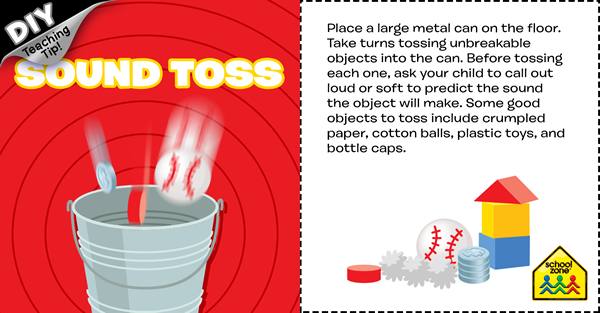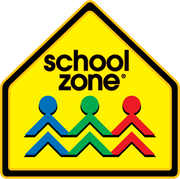DIY Learning
Alphabet Book
Open full-sized image in a new browser window.
Staple blank paper together to create a book. Help your child write a letter of the alphabet on the top of each page. Have your child look through the pictures in old magazines to find illustrations to cut out and paste on the appropriate pages of the alphabet book. Help your child print the names of the objects under the pictures.
Alphabet Crackers
Open full-sized image in a new browser window.
You will need:
1/2 c flour
1/8 tsp garlic salt
2 Tbsp sesame seeds
3 Tbsp cold butter
2 Tbsp ice water
Preheat the oven to 350° F. Mix flour, garlic salt, and sesame seeds in a bowl. Cut cold butter into the mixture. Stir until crumbly. Add ice water and mix. Form a ball. Roll out pieces of the dough to form tubes as wide as a pencil. Create alphabet letters with the dough.
Place the letters on a cookie sheet, and flatten the top of the letters slightly. Bake for 15 minutes at 350° F. Cool and eat.
These tasty treats will motivate your child to learn the alphabet. Ask your child to arrange the alphabet crackers a few at a time in ABC order. Then ask your child to spell his or her name.
Animal Campaign
Open full-sized image in a new browser window.
Ask your child to make a poster for a misunderstood animal such as a spider, a snake, or a bat. Your child's poster might explain why people should respect the animal.
Computing More & More
Open full-sized image in a new browser window.
Help your child practice counting objects by having him or her count things like money or pieces of candy in a large bag. When counting nickels and dimes, encourage your child to count by fives and tens. When counting a great number of pennies or candies, suggest grouping them by tens to facilitate the counting procedure in order to find the total.
Creative Endings
Open full-sized image in a new browser window.
Invite your child to create an original ending to a familiar story. Ask him or her to imagine what would happen if the characters made different decisions or if other story events changed. Your child could draw a picture to accompany the new story.
Dot-to-Dots
Open full-sized image in a new browser window.
Encourage your child to draw lines to connect dots. First, give your child sheets of blank paper on which to draw dots and connect them. For a challenge, ask him or her to number or letter the dots and connect them in order. Then have your child describe those dot-to-dot pictures.
Family Storytelling Quilt
Open full-sized image in a new browser window.
Tell your child a story about a family member. Afterwards, have your child draw a portrait of that person. Hang the picture on your child's bedroom wall. As an ongoing activity, have him or her draw a picture of other family members as you tell stories about them. Your child can tape the pictures together on the wall to make a family storytelling quilt. Encourage retelling the stories.
Helping the Environment
Open full-sized image in a new browser window.
Look for ways in which your family can help preserve the environment. Here are a few ways to get started: recycle everything you can, start a compost pile, use phosphate-free dish soap and laundry soap, avoid using pesticides, turn off lights and the television when you aren't in the room, choose reusable food storage containers instead of foil or plastic wrap, bring your own cloth bags to the grocery store, and buy locally grown products.
Jigsaw Jumble
Open full-sized image in a new browser window.
Have your child make a jigsaw puzzle of his or her own. Draw a picture on heavy paper. Cut it into 10-12 pieces. Give the puzzle to a friend to solve!
Living or Non-Living
Open full-sized image in a new browser window.
Take a walk outside and point out trees, rocks, a swing, etc. Indoors, make note of plants and pets. If you don't have pets, try this activity at a zoo or pet store. Ask your child to describe how living things are different from non-living things.
Making a Map
Open full-sized image in a new browser window.
Have your child make a map of one section of your town or city. Help take notes during a walk around this area. Encourage noticing the streets, kinds of buildings (stores, restaurants, public buildings), and natural areas (parks, flowers, ponds, lakes). As your child works on the map, remind him or her to label the streets and create a key with symbols for the different kinds of things shown on the map.
Name Game
Open full-sized image in a new browser window.
Ask your child to make up a silly sentence using words that start with the first letter of his or her name. For example: "Holly's huge hamster hid her hat in a hole."
Penny Count
Open full-sized image in a new browser window.
Lay out 50 pennies. Explain to your child that 1 dime equals 10 pennies. Sort the pennies in groups of 10. Put 1 dime by each group of pennies, and then skip count by tens.
Plant a Lima Bean
Open full-sized image in a new browser window.
Plant a lima bean seed in a can filled with dirt. Set it in a window and water it every day, just enough to keep the soil moist. Pretty soon, you will see your seed turn into a seedling and then a plant!
Practice Clock
Open full-sized image in a new browser window.
Draw a clock face minus hands on a paper plate. Cut out two arrow hands from construction paper. Make sure that the hour hand is shorter than the minute hand. Use a brass brad to attach the two hands to the center of the clock. Ask your child to set the minute hand at 12 and the hour hand at any number. Help your child tell the time. Change the hour hand and have your child tell the time again. When your child can read the hours easily, move the minute hand to the half-hour and quarter-hour positions and repeat the exercise.
Rainbow Factory
Open full-sized image in a new browser window.
Place a clear glass of water on a sunny, indoor windowsill. Put white paper near the windowsill. Move the paper around until a rainbow appears on the paper.
Rain Painting
Open full-sized image in a new browser window.
Sprinkle powdered paint on construction paper. Help your child place it outside for a few minutes on a rainy day. Ask him or her to predict what will happen. When you bring the painting inside, talk about how the rain changed the paint from powder to liquid.
Roasted Pumpkin Seeds
Open full-sized image in a new browser window.
You will need:
Pumpkin seeds
Cookie sheet
Vegetable oil
Salt
- Have an adult turn the oven to 250° F.
- Wash and dry some pumpkin seeds.
- Pour a light coat of vegetable oil on a cookie sheet.
- Spread the pumpkin seeds evenly over the sheet. Put salt on them, if you like.
- Bake the seeds for about 15 minutes. Have the adult stir the seeds so they don't burn, and return them to the oven for about 15 minutes more. When they turn golden brown, the seeds are done.
- Cool the seeds. Share them with a friend.
Shape Game
Open full-sized image in a new browser window.
To play this game, you will need a ball of string. One player calls out a shape with straight lines, such as a square, rectangle, or diamond. The next player takes the ball of string, holds on to the loose end, says one, and tosses the ball to another player. That player says two and moves into position to make the shape. He or she holds the string and tosses the ball of string to the next player. The game continues until the shape is completed.
Sound Toss
Open full-sized image in a new browser window.
Place a large metal can on the floor. Take turns tossing unbreakable objects into the can. Before tossing each one, ask your child to call out loud or soft to predict the sound the object will make. Some good objects to toss include crumpled paper, cotton balls, plastic toys, and bottle caps.
What Came Before
Open full-sized image in a new browser window.
"What Came Before?" is a card game you can play with your child during summer outings. Each player, in turn, takes a card, reads the invention, and then tells what came before it. Players get 1 point for each thing they name. Prepare several game cards by writing a modern invention on each one.
Sample cards and answers include microwave oven (stove, fire), computer (typewriter, pencil), jet airplane (train, horse), TV (radio, newspaper).
Ye Olde Diary
Open full-sized image in a new browser window.
Tell your child about a relative who lived several generations ago. Research together the types of transportation, communication, and major events that were going on during that person's life, as well as anything that he or she experienced personally.


